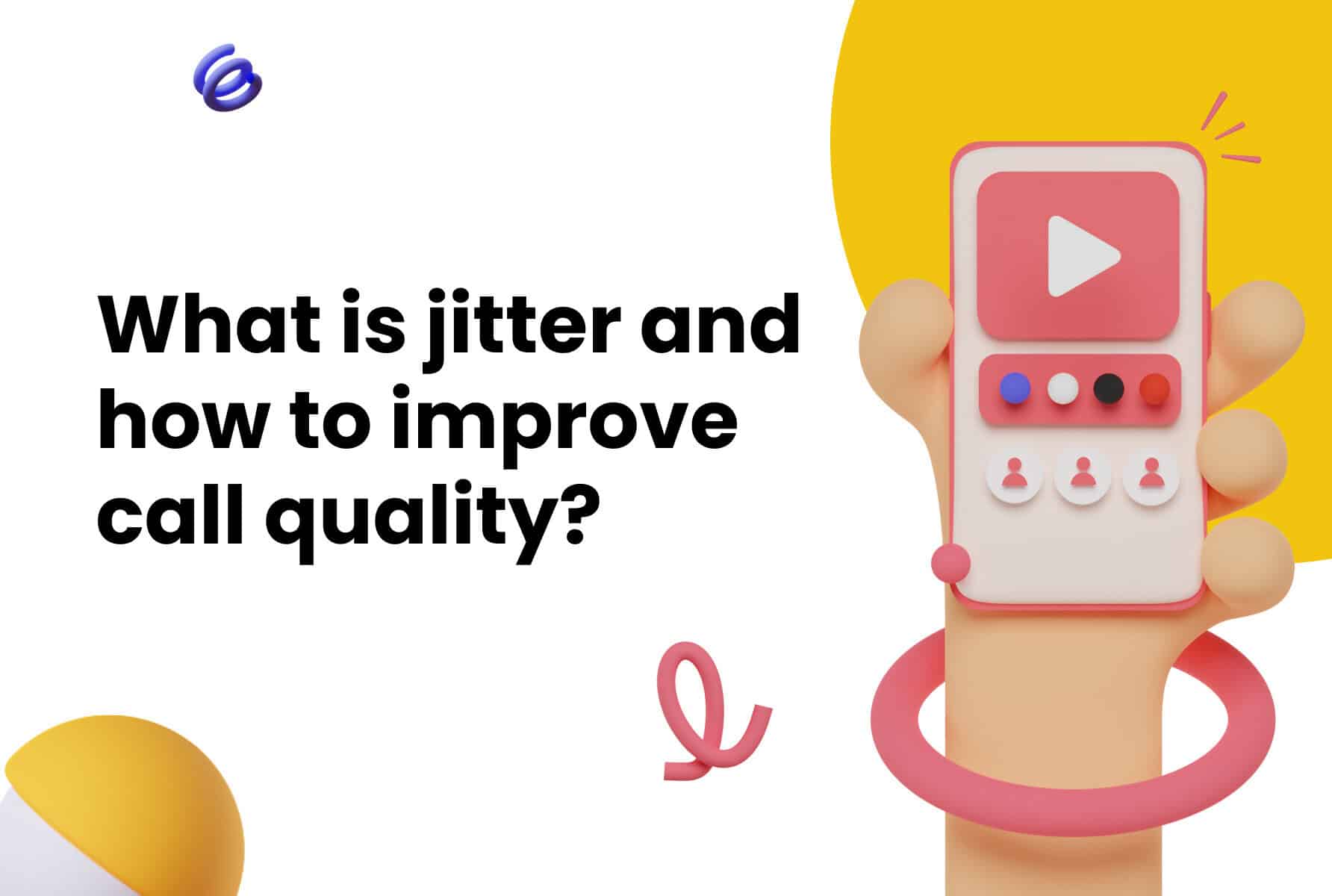The adoption of VoIP (Voice over Internet Protocol) is growing among companies in need of cost-effective phone systems that support expansion and boost productivity. In fact, VoIP software is now used by over 60% of startups and more than a third of SMEs and large businesses. As the need for a competitive advantage rises in a candidate-driven market, integrating VoIP technology with an existing CRM (Customer Relationship Manager) is a powerful means of handling more calls, streamlining workflows, and ultimately, making more job placements for recruiters.
What is VoIP?
Firstly, here’s a recap on VoIP.
Voice over Internet Protocol (VoIP) is a phone system that uses the internet to send and receive voice calls and multimedia content. Instead of using a Public Switched Telephone Network (PSTN) VoIP users can make calls easily from a PC.
Considered by businesses as a standard alternative to traditional phone systems, VoIP is also referred to as cloud-based calling, a virtual phone system or, IP (Internet Protocol) telephony.
Developed in the nineties, and surging in popularity since the pandemic, VoIP brings several business benefits. From multiple calling features, and an inexpensive and easy setup, to minimal maintenance, flexibility, scalability and secure calling.
The capabilities of VoIP are compounded when synced with a CRM system using a CTI (Computer Telephony Integration), as all call data can be saved directly into CRM records. This unification of data and automation relieves calling agents of their manual workloads and tasks, improving their productivity and helping business glean valuable and accurate data insights.
How does VoIP work?
Unlike traditional phone networks that use dedicated lines, VoIP converts voice data into digital packets via the internet and to another device. There are 4 top level steps included in this process:
- A VoIP call is initiated from either a PC, mobile device or VoIP handset
- Voice data is digitised into data packets using Codecs which compress and encode the voice data
- The data packets are sent over the internet using Internet Protocol
- When they reach their destination, they are converted back into an analogue format by Codecs, making the sounds recognisable to the receiver of the call.
Although the technology behind VoIP may sound convoluted, essentially, VoIP calls are made in much the same way as a standard phone call. Some businesses, generally those with low call volume, use a VoIP handset or a phone with an ATA adapter (Analogue Telephone Adapter) which allows it to connect to the internet. While companies handling a high-volume of calls often opt for a headset, microphone and softphone software combination.
Does my business need a softphone?
A softphone is a piece of downloadable VoIP software installed on a computer or device, allowing it to operate as a phone. The softphone interface resembles a dialling keypad and is used to initiate and receive phone calls. The CloudCall Communicator, for example, is a recognisable telephone interface which allows CloudCall customers to make VoIP calls.
The use of a softphone is significantly less expensive than traditional on-premise hardware phones. As well as providing a positive user experience for callers, many softphones come packed with features that rule out time-consuming manual dialling, freeing up time for other tasks. And because softphone applications can be installed on mobile networks and wi-fi-enabled devices, recruiters can take calls and gain access to their work phone features at any time, even when they are out of the office.
VoIP Glossary
VoIP telephony has a language and terminology of its own. Here’s a useful breakdown of some of the key terms VoIP and telephony terms.
Advantages and disadvantages of VoIP
| Advantages | Disadvantages |
| Cost savings No initial investment in a PBX is needed, unlike traditional phone systems. Plus, there are minimal maintenance expenses, and local and international calling costs are significantly less expensive than using PSTN. | The essential need for a reliable internet connection VoIP is dependent on a consistently high-speed internet connection. Call latency and lagging during a call occurs when data packets do not reach their destination, and when there is congestion in the network jitter can also arise. |
| Flexible and mobile VoIP calls can be made from anywhere with a softphone app, helping remote workers stay connected. Plus, you can use the same virtual number no matter what your location. | Impacted by power outages Although rare, power outages can result in VoIP services going down as a continual supply of energy is needed but an onsite backup generator can prevent this eventuality. |
| Improved scope for business expansion A VoIP infrastructure can grow at the same pace as your business, with no big investment in hardware needed. New users can be easily added which also means you are equipped for busy periods at no large expense. | Location tracking is limited Emergency calls are not possible using VoIP. Unlike landline numbers, VoIP phones are not linked to a postal address to help emergency services reach you. However, some VoIP suppliers can provide an emergency number associated with an address. |
Enhanced customer experience Together, the flexibility, call quality and ability to engage with customers through different communication channels makes for an improved experience. | |
High quality audio calls With a strong internet connection, VoIP calls are high quality and clear, with lagging and latency issues rare. | |
Advanced calling features VoIP has a full range of call features not always accessible or available with landline phone systems. Call recording, voicemail, tailored voice messages, and call forwarding are available with VoIP. | |
VoIP helps prepare for the future In 2025, ISDN (Integrated Services Digital Network) will be phased out. A previously popular but now old-fashioned telephony system ISDN relies on cables and hardware. Businesses using the technology will need to be ready for when there are no more line installations. | |
Improved sustainability Because there is no need for energy-consuming equipment such as telephone exchanges, cables and switchboards, environmental impact is also reduced using VoIP. |
On balance, the potential to expand operations, improve productivity, and save costs through the use of VoIP far outweigh the drawbacks. Plus, most of the obstacles with VoIP can be successfully addressed thanks to the increase of broadband speeds, and the availability of more reliable internet connections. With the latest updates installed on your VoIP system, and compatible hardware, latency is usually an issue which can be easily resolved too.
Digital transformation and the rise of VoIP
Although VoIP is not a new technology, its implementation increased significantly during the pandemic when virtual working and video conferencing became the new norm, resulting in a digital transformation boom.
The sudden onset of digitalisation and automation is perhaps the reason why staffing companies now rank tech as a highly valuable asset, with Applicant Tracking Systems like Bullhorn and Salesforce considered the most valuable in their tech stack, according to Staffing Hub’s State of Staffing 2023 report. It’s also likely that because recruiters are operating with a record high number of job vacancies and a diminishing pool of talent, competition is fierce and technologies like VoIP offer a tangible means of gaining an edge.
With candidates at the helm in the job market, it’s critical for recruiters to find fruitful ways to attract and build professional relationships. For instance, when promoting a role to a passive candidate who is not actively looking for a new position, communicating the right information at the right time is key to securing a new placement. Also, when finding the best fit for a new role, having access to accurate candidate data ensures recruiters are making sound role/candidate matches and more objective choices. When a VoIP/CRM integration harnesses the value of a CRM, salespeople and recruiters hit their targets, place more new hires and improve overall profitability.
What is VoIP and CTI?
A CTI (Computer Telephony Integration) is the middle-man that combines VoIP software with CRM software. This consolidation automatically syncs data between the two softwares, maximising the power of each and allows users to access and exchange data from a central, single source of truth (SSOT). This brings about numerous communication, data and efficiency benefits. Let’s have a look at those.
Benefits of CTI
Increased productivity
Enhanced productivity pays dividends over time. Here are some of the efficiencies you can expect with a CTI.
A more seamless process
Recruiters working with a standalone CRM must switch between different platforms or refer to manually written notes to access relevant data before, during and after calls. This can be off-putting for the call receiver and frustrating for the call handler. With a VoIP CRM integration, all contact details including call logs, call recordings, notes and SMS texts are automatically logged in the CRM system, within the caller’s record, and displayed on the screen.
This means when agents pick up the phone, all relevant and up-to-date contact details are readily available. Similarly, when inbound calls arrive, a screen pop displays all contact details and links with the caller’s CRM record. So, there’s no scrambling to find or write notes on other devices or sounding hesitant and unsure when trying to remember what was said in a previous call. A more streamlined process means call handlers have greater leeway for making more calls and improving the quality of conversations – both of which support increased customer lifetime value and brand reputation goals.
More time available
When reaching out to candidates, establishing contact can eat into valuable time. Instead of sending individual, time-consuming messages after unsuccessful contact, callers can use SMS broadcasts to send multiple follow-up messages to all recipients they are unable to reach that day. Sending a broadcast SMS also means time-critical messages such as job opportunities or interview details can be delivered to candidates who may be temporarily unavailable. Plus, engaging with contacts on different channels only enhances the overall customer experience.
Click-to-call and power dialling are other time-saving tools afforded by a CRM integration, allowing recruiters to call numbers in quick succession. If a line is engaged or there is no answer, the system automatically calls the next contact on the list, with no input from the call handler needed. Although this may sound a negligible amount of time to gain, when agents have hundreds of calls a day to get through, manual dialling can result in lots of productive time wasted. And, when time is of the essence, gaining contact with a client or candidate before your competitor does can make all the difference.
Improved data accuracy
On a busy day speaking to candidates, arranging interviews, and making sales calls, information can be easily lost, missed or prone to errors. A VoIP/CRM integration means callers have full confidence in the information they are using, giving assurance to call recipients and supporting a more productive and rewarding interaction for both parties. Mistakes and inconsistencies can also occur in the high volume of voicemail recordings call handlers must leave on a daily basis. Using Voicemail drop, callers can prepare a pre-recorded message that hits all the right notes, and when calls go unanswered it can be sent with a single click
More flexibility
In today’s working environment, the greater the flexibility, the greater the productivity. Through VoIP and CRM integration and the installation of a mobile app on your teams’ smartphones or devices, recruiters regularly out of the office can access information, make calls and join meetings at any time. Working as an extension of your CRM, client and candidate data can be easily retrieved and managed while on the move. This means less time is spent catching up on communication when back in the office, and more time available for focusing on leads. Being able to respond and communicate anywhere at any time also supports improved team collaboration.
Greater cost efficiencies and scalability
Naturally, enhanced productivity leads to business growth in the long-term, but there’s also huge potential to scale at pace with a CRM and VoIP integration. Small businesses and startups can capitalise on the flexibility of VoIP technology to expand their operations simply and cost-effectively. With no traditional phone infrastructure, hardware, copper cables, or on-site servers, installation, repair and maintenance costs are kept to a minimum, leaving more capital for other business investments.
According to an employment and labour market report by the ONS, the number of people planning to work more from home has risen. With the popularity of virtual employment set to continue, offering remote and hybrid working patterns means recruitment businesses can broaden their scope and attract and maintain the kind of talent that will help them grow.
Remote and flexible working does, of course, have its challenges. Working off-site means it can be difficult to track team activities or provide staff with relevant training. But, with real-time coach functionality, team members can benefit from one-to-one advice, coaching and training from their managers. During live calls, coaches can offer guidance on how to respond to a caller, without the caller knowing a coach is present. This virtual yet hands-on approach means managers can monitor calls from anywhere to gain a firm understanding of what is happening in their team. It also improves confidence and performance for remote workers, helping them to build on their targets and improve the company’s bottom line.
VoIP technology even presents new opportunities for companies that want to expand internationally, with considerably lower international calling charges than those made using a PSTN and the option of local presence dialling. That being said, when contacts don’t pick up calls or respond to voicemails, it can put a fly in the ointment of both regional and international expansion plans. By adopting a local presence through VoIP technology, outbound calling pick-up rates increase significantly. This is because recipients are much more likely to answer calls from a local number than they would an unrecognisable number. So, if you’re looking to expand into new geographical areas, then a local presence is essential, and possible with VoIP.
More data = stronger decision making
A study by Harvard Business Review for Google Cloud, reveals how companies with a data-driven strategy were in a stronger position to navigate the unpredictability of the pandemic, and accurate data integrated throughout the company was influential in real-time decision making during critical times. As recruiters continue to face uncertainty it makes sense that opportunities to capture data should be capitalised upon as much as possible.
However, plentiful, high quality and accurate data is a rarity without a CRM and VoIP integration. Data entry mistakes are easily made and when an employee leaves the business, they potentially take their data with them, creating gaps in communication.
Using a tool like CloudCall’s History feature ensures all call communication is collected and stored automatically within the CRM system. This means data is clean, correct and available to all other system users. It introduces a better flow of information across an organisation, and prevents overall data leakage. Using call notes and call recordings valuable insights can be extracted and analysed to create meaningful KPIs.
Analysing calls with live dashboards allows for an even deeper dive into real-time call metrics such as call volumes, average call times (Average Handling Time – AHT), and the types of calls that are being made. These analytics help improve resourcing, and to identify specific areas for improvement. They also provide an objective guide on how businesses can improve performance.
Improved CRM adoption
CRM systems require significant financial injection but adoption and buy-in from users can be challenging and result in a poor return on investment. Often sales-focussed individuals want to get on with selling and associate CRM systems with cumbersome data entry tasks. It can take time to see the benefits and efficiencies of a CRM, but when integrated with VoIP there is a more immediate impact.
For example, today, most employees bring their own personal devices to the workplace, but when work information is stored on them, details can be mistakenly lost or unavailable when a former team member has moved on. This means that important, up-to-date information on a client or candidate is not available when needed, leading to frustration for other team members.
However, when call data, contact notes and SMS texts are synced automatically into CRM records, no other applications or devices are needed to manually record notes. This improves the experience for call handlers as the likelihood of missing data is reduced and their lives are made simpler through not having to use their time inputting data. This more positive user-interaction with a CRM system helps increase rates of adoption and improve perceptions.
And finally…
If you’re ready to take the next step with a CRM/VoIP integration, and want to breathe new life into your current communications, get in touch to book a demo with CloudCall. We offer a unique integration that’s built inside your existing CRM to create and maintain personalised customer experiences.



